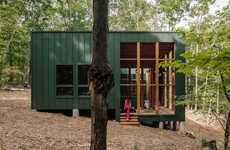An attention-captivating patterned facade has been added to the exterior aesthetic experience of the Elphin House in Ivanhoe — a suburb in Melbourne. The firm responsible for this elegant infusion is Julie Firkin Architects, who also added some other unconventional aspects to the building's silhouette that give the abode character but also place it in favor of contemporary movements of design. A great example of this is the pitched roof that is slightly mismatched.
For the composition of the patterned facade, Julie Firkin Architects drew inspiration from "foliage and textiles." Not only does this feature instill a potent visual character to the Elphin House — one that is surely unique to the neighborhood, but it also plays a functional role. That is, the patterned facade regulates the building's exposure to the sun in a favorable way.
Photo Credits: Christine Francis, courtesy of BowerBird
Textile-Inspired Facades
Julie Firkin Architects Boasts a Striking Patterned Facade for This Abode
Trend Themes
1. Patterned Facades - The use of patterned facades in architecture creates visually captivating and unique building exteriors.
2. Textile-inspired Designs - Incorporating textile-inspired designs in architecture offers innovative possibilities for creating aesthetically pleasing and functional spaces.
3. Mismatched Pitched Roofs - Intentionally mismatched pitched roofs provide a contemporary twist to traditional architectural elements.
Industry Implications
1. Architecture - Architects and designers can explore opportunities to incorporate patterned facades and textile-inspired designs into their projects to stand out in the market.
2. Building Materials - Manufacturers of building materials can develop innovative materials that mimic textiles and patterns for use in facade construction.
3. Solar Energy - The use of patterned facades in buildings can be explored as a way to optimize solar energy exposure and regulate heat gain, presenting opportunities for solar energy companies.






